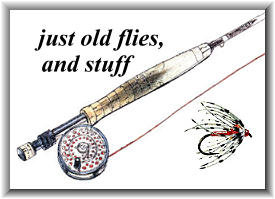We don't often come across an 'old fly' for
saltwater - but here is a dandy! Wouldn't you
love to try it? Bet it works!
The Cracker was first tied in 1890 from a pattern
designed by Dr. George Trowbridge, of New York, for
use in Florida. At that time it was rated as "by
far the most killing for Florida fishing, that has
yet been tested." It was said to to "too gay and
complicated to attempt to describe with clearness."
The doctor used it for tarpon and channel bass
fishing at Sarasota. On February 23, 1887, the Dr.
caught a 17 poung channel bass on a fly.
Dr. Trowbridge said, "because it was born, brought
up and a native of Florida, it was given a native's
name."
The dressing given in Forgotten Flies, Preston Jennings recipe is:
Tag: Oval silver tinsel and yellow floss.
Tail: Blue and yellow goose, and peacock swords.
Body: Deep blue dubbing.
Rib: Round gold tinsel.
Wing: White, black, red, and blue goose, married;
peacock swords over top.
Hackle: Red.
Head: Red wool.
Credits: Text from Fly Patterns and Their Origins,
By Harold Hinsdill Smedley. Color photo and recipe from
Forgotten Flies published by Complete
Sportsman.
|



